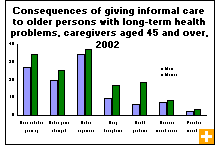Common menu bar links
Who is caring for the elderly?
Archived Content
Information identified as archived is provided for reference, research or recordkeeping purposes. It is not subject to the Government of Canada Web Standards and has not been altered or updated since it was archived. Please contact us to request a format other than those available.
In 2002, more than two million people-most of them relatives and friends aged 45 to 54-were providing informal care to seniors. Some caregivers were seniors themselves, with a small proportion aged 75 and over.
The tasks provided differed by gender: men took care of tasks outside the house, whereas women looked after housework and provided personal care, a particularly demanding task that can be time-consuming.
Caring for an elderly person can constrain a caregiver's lifestyle. They give up social and recreational activities, have less time for relationships, incur extra expenses, must change schedules and work patterns, refuse or leave employment, or lose income.
 Caregiving
can also cause sleep disturbances and health problems, most markedly
among women. Among caregivers in the 45-to-64 age group, 1 in 10 men
and nearly 2 in 10 women in 2002 reported sleep disruptions. Health problems
were cited by 7% of men and 21% of women. Similar differences by gender were
observed in older caregivers. Regardless, most caregivers had a positive
attitude about providing this care.
Caregiving
can also cause sleep disturbances and health problems, most markedly
among women. Among caregivers in the 45-to-64 age group, 1 in 10 men
and nearly 2 in 10 women in 2002 reported sleep disruptions. Health problems
were cited by 7% of men and 21% of women. Similar differences by gender were
observed in older caregivers. Regardless, most caregivers had a positive
attitude about providing this care.
Life can be busy for members of the sandwich generation-those who care for a senior citizen, who have a child at home and who, in many cases, must balance paid work and family life. In 2002, these people were much more likely to want a flexible work schedule or respite care in order to be able to offer better care for their elderly relatives.


